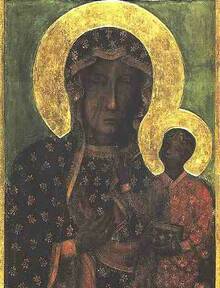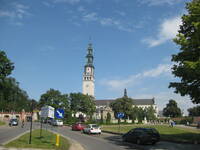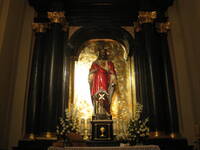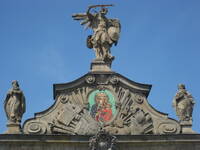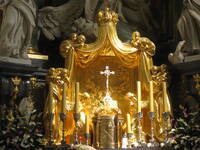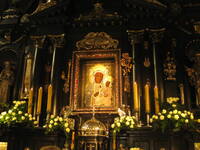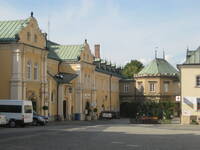Jasna Góra Monastery in Częstochowa, Poland
Blessed John Paul II was a pilgrim to the Marian shrine of Jasna Góra in 1979, 1983, 1987, 1991 (for World Youth Day Częstochowa), 1997 & 1999. Papa Benedict XVI also visited the Black Madonna during his pilgrimage to Poland in 2006.
The icon of Our Lady of Częstochowa has been intimately associated with the history and culture of Poland. Its history prior to its arrival in Poland is shrouded in numerous legends which trace the icon's origin to St. Luke who painted it on a cedar table top from the house of the Holy Family.
In 1430 the Pauline monastery was stormed by Hussites, who plundered the sanctuary. After putting the icon in their wagon, they tried to get away but their horses refused to move. They threw the portrait down to the ground and one of the plunderers drew his sword upon the image and inflicted two deep strikes. When the robber tried to inflict a third strike, he fell to the ground and squirmed in agony until his death. Despite past attempts to repair these scars, they had difficulty in covering up those slashes. Another take on the story is that, as the robber struck the painting twice, the face of the Virgin Mary started to bleed; in a panic, the scared Hussites retreated and left the painting.
The Black Madonna is credited with miraculously saving the monastery of Jasna Góra from a 17th-century Swedish invasion, The Deluge. The Siege of Jasna Góra took place in the winter of 1655 during the Second Northern War / The Deluge. Their month-long siege however was ineffective as a small force consisting of monks from the Jasna Gora monastery led by their Prior and supported by local volunteers, mostly from the szlachta (Polish nobility), fought off the numerically superior invaders, saved their sacred icon and, according to some accounts, turned the course of the war. This event led King John II Casimir Vasa to "crown" Our Lady of Częstochowa ("the Black Madonna") as Queen and Protector of Poland in the cathedral of Lwów on April 1, 1656.
Krzysiek, from Poland ![]()
"The second story I really like is a family story when my grandmother's sister during World War II got arrested by German soldiers and she was taken to the camp in Częstochowa from where she was supposed to be sent further away .. My grandmother's sister managed to escape the camp .. She went to the cloister, she prayed in front of the picture of the Virgin Mary, then she went to the train station. .. She was on the station, her train arrived and then she got a very, very strong feeling to go back to the cloister to see the Virgin Mary again. She had no idea why she would need to do it but she felt she had to do it. So she went back to the cloister (a 2km walk) and she found her mother there. .. It was a miracle that they managed to meet and they went back home happily."
Kamel, from Poland ![]()
"The Virgin Mary is my mum, basically. I converted some time ago and I was always close to that town in Poland which is called Czestochowa, where many miracles have happened through the Virgin Mary and that place has a beautiful church which is known around the world. I went there one day, I just prayed, like I didn't really pray, I didn't really believe, I just asked "God, if you exist, Virgin Mary, if you exist, show me the truth." And there were 3 of us, not one of us believed at that time and in that year all 3 people converted through Mary and her blessed heart. And now every day I am just finding her power, her faith, and her humble and quiet heart, and how much she shows me the way to Christ and how wonderful she is to me. And it is very interesting because I just find out the way to pray through the rosary, which I was like so stubborn not to do for more than a year and a half.."
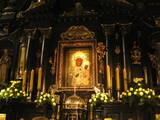
Ryan, a pilgrim from the United States ![]()
"What’s special about Czestochowa is there’s this painting by Saint Luke and it’s beautifully adorned and it has brought so many healings and so many miracles to people from all around the world who come to venerate this image. But this image was special to me because there's a part of the image that was cut by someone who was trying to attack it. It’s an image of Our Lady holding the Christ Child and it’s beautiful, you are just in awe of it when you see it. But she has these two scars across her face and it’s beautiful because it’s symbolic what they're saying, that she wanted to say to the pilgrims who come to venerate her that she is suffering with us. And we can see the scars, that she is taking our suffering. And it just brought me so much closer to our Blessed Mother through this image because I think it shows that we have a mother who is willing to not only go through the joys with us but to go through the sufferings with us. And she is happy to be with her children, especially when we are suffering."
Jack, from the United States ![]()
"When it comes to Mary, I have a great devotion to Our Lady of Częstochowa. She sits in my room wherever I go; I bring her with me even when I travel. The image of her, she has a scar from when she was taken out of the church in Częstochowa and stabbed. They've tried to fix it and it always comes back - she chooses the scar, and I think that's beautiful. I think it shows her motherly care for her children: it's a bruised world, a scarred world and she wants to be right there with us. And yet still shows how our scars can be beautiful to the Lord. She's more than a role model, she's an intercessor and she really does show us the true and beautiful way to Christ."
Sebastian, from Poland ![]()
"Mary was always important in my faith. In Poland we have got a very important place for Mary, it's called Czestochowa, Jasna Gora and I have been there many times on pilgrimage. What is for me very important is that Mary doesn't want to know every time the answer for every question; sometimes she is just in silence and takes what God gives her."
